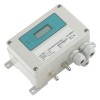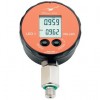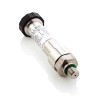Pascal is the SI unit for pressure and is derived from other SI units using the following relationship: Pa = (kg.m/s²)/m² = kg/m.s² = N/m².
Since 1 pascal is a very low pressure being 1/100 of a millibar, it’s use is limited to ultra low gas pressure applications such as measuring the pressure differences in ventilation systems.
The pascal is more commonly used as larger multiples of the unit which are the hectopascal (hPa), kilopascal (kPa) and the megapascal (MPa) unit, these are more practical when measuring mid range pressures.
Unlike other units such as psi, kgf/cm2, mH2O and inHg the pressure value that the pascal unit represents is unchanging no matter where and how it is used. The pascal unit is completely independent of ambient temperature, local gravity and media density.
To determine the equivalent value of a pascal measurement in other units you can multiply it by the choices displayed in the table below.
To convert multiple values from or to pascals please use the online conversion tool for pressure.
Featured pa - pascal based unit range pressure measurement products
 0 to 9 pascals range pressure gauge - Low Pascal range pressure gauge for measuring from 0 to 9 pascals and provide a digital readout of the pressure readings?
0 to 9 pascals range pressure gauge - Low Pascal range pressure gauge for measuring from 0 to 9 pascals and provide a digital readout of the pressure readings? 10 kPa orifice plate differential pressure transmitter for water flow measurement - Pressure sensor for measuring the differential pressure generated by water flowing through an orifice plate in a pipe, and converting the output to a water flow measurement.
10 kPa orifice plate differential pressure transmitter for water flow measurement - Pressure sensor for measuring the differential pressure generated by water flowing through an orifice plate in a pipe, and converting the output to a water flow measurement.
Conversion Factors
- 0.00001 bar
- 0.0001450377 psi
- 0.01 mbar
- 1 N/m²
- 1 Pa
- 0.01 hPa
- 0.001 kPa
- 0.000001 MPa
- 0.0000101972 kg/cm²
- 0.101972 mmH2O 4°C (39.2°F)
- 0.0101972 cmH2O 4°C (39.2°F)
- 0.000101972 mH2O 4°C (39.2°F)
- 0.00401463 inH2O 4°C (39.2°F)
- 0.000334553 ftH2O 4°C (39.2°F)
- 0.00750062 mmHg 0°C (32°F)
- 0.000750062 cmHg 0°C (32°F)
- 0.000295300 inHg 0°C (32°F)
- 0.00750062 Torr
- 7.50062 mTorr
- 0.00000986923 atm
- 0.0000101972 at
- 10 dyn/cm²
- 0.00232060 oz/in²
- 7.50062 µHg 0°C (32°F)
- 0.0000000647490 tsi (uk, long)
- 0.0000000725189 tsi (usa, short)
- 0.0000104427 tsf (usa, short)
- 0.0208854 psf
- 0.0101972 g/cm²
Please note that the conversion factors above are accurate to 6 significant figures.
Conversion Tables
Select a look up table for converting a pressure reading in pascals to other measurement units.
- psi » 100 to 100,000 Pa → 0.0145038 to 14.5038 psi
- bar » 100 to 200,000 Pa → 0.001 to 2.000 psi
- mmH2O » 1 to 1000 Pa → 0.101972 to 101.972 mmH2O
- inH2O » 1 to 1000 Pa → 0.00401463 to 4.01463 inH2O
- mmHg » 1 to 1000 Pa → 0.00750062 to 7.50062 mmHg
- Torr » 1 to 1,000 Pa → 0.00750062 to 7.50062 Torr
Featured pa - pascal based unit range pressure measurement products
 1000 bar, 15000 psi, 100 MPa Pressure Gauges, Meters & Manometers - High range pressure gauges with a measurement range from 0 to 1000 bar or 15,000 psi.
1000 bar, 15000 psi, 100 MPa Pressure Gauges, Meters & Manometers - High range pressure gauges with a measurement range from 0 to 1000 bar or 15,000 psi.  Leak testing at 0.5 bar to detect 200 Pascal pressure drop - The parts have to be checked at 0.5bar pressure. We are interested in measuring leakage which results in a drop of 200Pa pressure over a period of 10 sec.
Leak testing at 0.5 bar to detect 200 Pascal pressure drop - The parts have to be checked at 0.5bar pressure. We are interested in measuring leakage which results in a drop of 200Pa pressure over a period of 10 sec.
Help
Vacuum level of 5 Pa
Can you tell me in laymen terms, how much vacuum equals 5 Pa?
All pressures below atmospheric pressure are considered vacuum. 101,325 Pa is 1 standard atmosphere. Therefore 5 Pa would be ~ 0.005% of atmosphere, so small in comparison to the total vacuum range.
However vacuum can be referenced to atmospheric pressure or a perfect vacuum. So 5 Pa below atmospheric pressure (-5 Pa gauge) would be a very slight suction pressure, but if it is 5 Pa above a perfect vacuum (5 Pa absolute) it would be a strong vacuum at the opposite end of the vacuum scale.
What is the relationship between pascal, bar and Newton per meter squared?
Pascal relationship to N/m² & bar
The pascal pressure unit is actually the SI unit derived from 1 Newton per Square Metre. The bar pressure unit is exactly equal to 100,000 pascals or N/m2
- 1 N/m2 = 1 Pa
- 1 bar = 100,000 Pa
SI unit for pressure
What is the SI unit of measurement for pressure?
The SI units for pressure are pascals. Since pressure is derived from the force acting on a unit area, pascals are derived from the SI units for Force and Area which are Newtons and Metres respectively.
Pressure = Force / Area = Newton per Square Metre (N/m2) = Pascal (Pa)
KpH wind speed to pascal pressure conversion
How do you convert a wind speed in kph to a pressure in pascal?
This page explains how to convert wind speed to pressure, and you can use this tool to convert wind speed to pressure values.
Featured pa - pascal based unit range pressure measurement products
 Heating appliance chimney draft and barometric pressure testing using differential and absolute sensors - Very low, bi-directional chimney draft pressure and barometric pressure sensor for testing preformance of wood stoves in a research environment.
Heating appliance chimney draft and barometric pressure testing using differential and absolute sensors - Very low, bi-directional chimney draft pressure and barometric pressure sensor for testing preformance of wood stoves in a research environment. Airflow and chamber pressure measurement for a portable modbus data acquisition trolley - Differential pressure sensor and a analogue signal to Modbus RTU RS-485 converter provided a flexible solution for measuring bidirectional pressures from a test chamber and an orifice plate on a mobile test rig.
Airflow and chamber pressure measurement for a portable modbus data acquisition trolley - Differential pressure sensor and a analogue signal to Modbus RTU RS-485 converter provided a flexible solution for measuring bidirectional pressures from a test chamber and an orifice plate on a mobile test rig.
Glossary of Low Pressure technical terms
- g Effect
- inH2O – Inches of Water Column at 4 deg C Pressure Unit
- mmH2O – Millimetres of Water Column at 4 deg C Pressure Unit
- oz/in² – Ounce per Square Inch Pressure Unit

